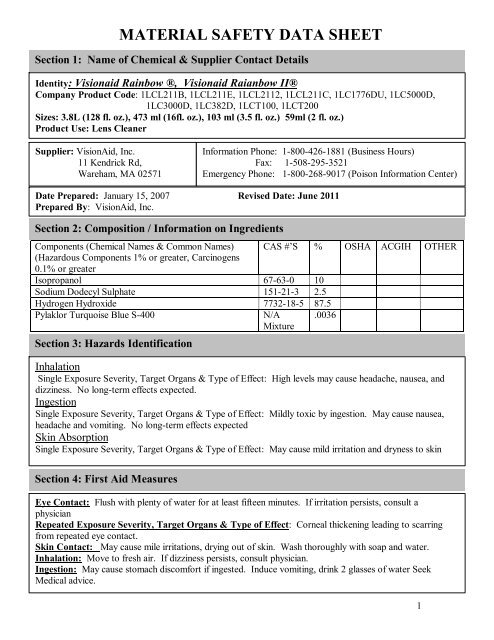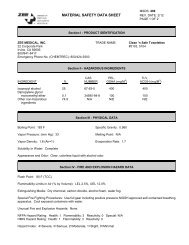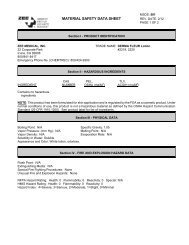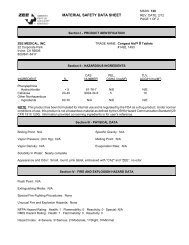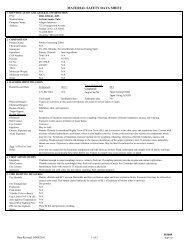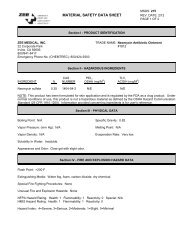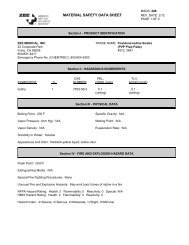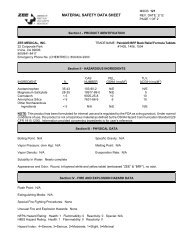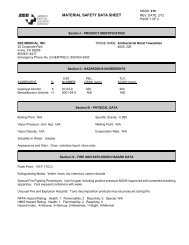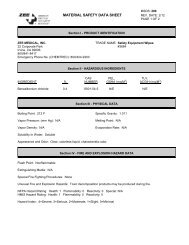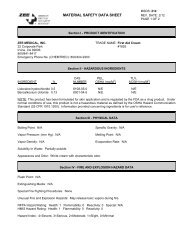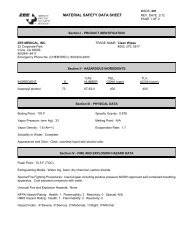MSDS - Zee Medical
MSDS - Zee Medical
MSDS - Zee Medical
Create successful ePaper yourself
Turn your PDF publications into a flip-book with our unique Google optimized e-Paper software.
MATERIAL SAFETY DATA SHEETSection 1: Name of Chemical & Supplier Contact DetailsIdentity: Visionaid Rainbow ®, Visionaid Raianbow II®Company Product Code: 1LCL211B, 1LCL211E, 1LCL2112, 1LCL211C, 1LC1776DU, 1LC5000D,1LC3000D, 1LC382D, 1LCT100, 1LCT200Sizes: 3.8L (128 fl. oz.), 473 ml (16fl. oz.), 103 ml (3.5 fl. oz.) 59ml (2 fl. oz.)Product Use: Lens CleanerSupplier: VisionAid, Inc.11 Kendrick Rd,Wareham, MA 02571Information Phone: 18004261881 (Business Hours)Fax: 15082953521Emergency Phone: 18002689017 (Poison Information Center)Date Prepared: January 15, 2007 Revised Date: June 2011Prepared By: VisionAid, Inc.Section 2: Composition / Information on IngredientsComponents (Chemical Names & Common Names) CAS #’S % OSHA ACGIH OTHER(Hazardous Components 1% or greater, Carcinogens0.1% or greaterIsopropanol 67630 10Sodium Dodecyl Sulphate 151213 2.5Hydrogen Hydroxide 7732185 87.5Pylaklor Turquoise Blue S400N/AMixture.0036Section 3: Hazards IdentificationInhalationSingle Exposure Severity, Target Organs & Type of Effect: High levels may cause headache, nausea, anddizziness. No longterm effects expected.IngestionSingle Exposure Severity, Target Organs & Type of Effect: Mildly toxic by ingestion. May cause nausea,headache and vomiting. No longterm effects expectedSkin AbsorptionSingle Exposure Severity, Target Organs & Type of Effect: May cause mild irritation and dryness to skinSection 4: First Aid MeasuresEye Contact: Flush with plenty of water for at least fifteen minutes. If irritation persists, consult aphysicianRepeated Exposure Severity, Target Organs & Type of Effect: Corneal thickening leading to scarringfrom repeated eye contact.Skin Contact: May cause mile irritations, drying out of skin. Wash thoroughly with soap and water.Inhalation: Move to fresh air. If dizziness persists, consult physician.Ingestion: May cause stomach discomfort if ingested. Induce vomiting, drink 2 glasses of water Seek<strong>Medical</strong> advice.1
Section 5: Fire Fighting MeasuresFlammability Classification (29 CFR 1910.1200) Combustible Liquid.Flash Point and Method: 82% C (180ºF)Flammable Limits in Air – 2.5%12.0% (Isopropanol)Auto Flammability and Autoignition Temperature: 456ºC (825ºF) (Isopropanol)Section 6: Accidental Release MeasuresContainment Technique: Prevent from entering waterways and storm sewers.CleanUP Technique: Contain spill. Cover spill with inert absorbent (absorball, vermiculate). Using nonsparkingtools, shovel or sweep up into a clean container. Remove from area. Flush spill area with water.Evacuation Procedures: Follow normal Emergency Response Plan (ERP)Section 7: Handling and StorageHandling Practices: Use grounding wires if transferring large quantities. Keep away for oxidizers, heatand other ignition sources. Do not allow to freeze.Conditions for Storage: Keep away from oxidizers, heat and other ignition sources. Do not store in directsunlight. Store in cool, dry wellventilated area. Do not allow to freeze.Ventilation Requirements For Storage: None requiredStorage Temperature: Below 40ºC (104ºF)Storage Humidity Range: Not applicableQuantity Limits for Safe Storage: Not applicableSpecial Materials to be used for Packaging or Containers: Not applicableSection 8: Exposure Controls / Personal ProtectionRespiratory Protection (Specify Type): NoneHygiene Recommendations to Prevent Continued Exposure: Use normal good industrial hygienepracticesProtection Gloves: NoneEye Protection: Safety GlassesVentilation to be Used: N/A Local Exhaust: N/A Special: N/AMechanical (General): N/A Other: N/AOther Protective Equipment: Not RequiredHygienic Work Practices: Always read the label before use.Section 9: Physical and Chemical PropertiesPhysical State: Liquid Specific Gravity (H2O=1) 1.00PH Factor: N/AFreezing Point: 6ºC (21ºF)Boiling Point: 93ºC (200ºF)Melting Point: : 6ºC (21ºF)Vapor Pressure 20 mmHg at 20ºC (68ºF) Evaporation Rate: 0.99Vapor Density 1Water Reactive: NoneSolubility in Water: 100% Specific Gravity (Relative Density): 98Percent Volatile: 10%Appearance and Odor: Clear blue solution. Slight alcoholic odor2
Section 10: Stability and ReactivityStability: Unstable: No Stable: YesConditions to Avoid: High temperatures, flame and other ignition sourcesIncompatibility (materials to avoid): Strong oxides of carbonHazardous Decomposition Products: Oxides of carbon (Coχ)Significance of Change in Physical Appearance: Under severely cold temperatures product may beginto turn cloudy which may degrade its functionality.Conditions of Reactivity: Do not heat above 80ºC (176ºF)Section 11: Toxicological InformationEyes: Irritant with danger of eye injury – May irritate eyesSkin: Irritant – May cause mild irritations, drying out skinInhalation: Irritant – No long term effects expectedIngestion: Irritant – Mildly toxic by ingestion, may cause nausea, headache & vomitingSection 12: Eyes Ecological InformationECOTOXICITYAcute and Long Term Toxicity to Fish and Invertebrates: Solutions of alcohols. Are toxic to aquaticlife at moderate to low concentrations. No longterm ecological effects are likely.Toxicity to Aquatic and Terrestrial Plants: Concentrated solutions of alcohols and surfactants maycause damage to aquatic and terrestrial plants.Acute and Dietary Toxicity to Birds: Not expected to be toxic.Toxicity to Beneficial Microorganisms: Concentrated solutions of alcohols and surfactants haveantimicrobial activity.ENVIROMNENTAL FATEPersistence and degradation: Moderately persistent but is biodegradable over time.Bioaccumulation/Bioconcentration: Will not bioaccumulateSoil Mobility: Similar to water.Section 13: Disposal ConsiderationsPlease note: The advice in this section is given in accordance with the laws that were in effect at the time.Laws are transient and may change or be reinterpreted. State/Provincial or Local regulations arecomplex and may differ from Federal regulations. This information applies to the material asmanufactured: processing, use or contamination may make the information inappropriate, inaccurate orincomplete. These regulations may also apply to empty containers, liners, and rinsate. Remember thatthe responsibility for proper waste disposal lies with the owner of the waste. See Section 15 RegulatoryInformation for additional regulations.Classification Under Applicable Laws: RCRA: Not listedIdentification:Not listedWaste Disposal Method:Incinerate in an approved incinerator, or landfill. ConsultLocal RegulationsDisposal of Packaging:No restrictions.Safe Handling of Residues:Not RequiredCan Packaging be Incinerated: YES in an approved incineratorCan Packaging be Recycled: YES triple rinsed containers may be recycledCan Packaging be Landfilled: YES3
Section 14: Transportation InformationSpecial Shipping Instructions and Precautions Within Premises:Special Shipping Instructions and Precautions Off PremisesDOT Classification/Description:TDG Classification /Description:Classification/Description under International Transportation Regulations:Not RegulatedNot RegulatedNot RegulatedNot RegulatedNot RegulatedSection 15: Regulatory InformationSYMBOLS:TOXICFLAMMABLELow FlashPoint(no symbol)RPHRASES:R22 Harmful if SwallowedR36 Irritating to EyesSPHRASES: S2 Keep out of reach of childrenS13 Keep away from food, drink and animal feeding stuffS15 Keep away from heatS25 Avoid contact with eyesS26 In case of contact with eyes, rinse immediately with plenty ofwater and seek medical adviseS46 If swallowed, seek medical advise immediately and show thiscontainer of label4
US FEDERAL REGULATIONSOSHA:TSCA(Toxic Substances Control Act)FIFRA(Federal Insecticide Fungicide,and Rodenticide Act)This product is classified as an Eye and Skin Irritant under OSHAStandard classification system.Ingredients of this product are on the US TSCAExport Notification: Isopropanol Export Notification RequiredNot applicableCERCLA:Not Listed(Comprehensive Environmental ResponseCompensation, And Liability Act)EPCRA: (SARA Title III[SuperfundAmendments and Reauthorization])CAA (Clean Air Act) :CWA (Clean Water Act):FDA/USDA (Food and Drug Act):NFPA (National Fire PortectionAssociationNot ListedNot ListedNot ListedNot applicableNFPA Classification Fire=1 (Slightly Flammable),Health=1 (Slightly Hazardous)Reactivity=0 (Stable)CANADIAN REGULATIONSWHMIS (Workplace HazardousMaterials Information System)CEPA (Canadian EnvironmentalProtection Ace)/ DSL (DomesticSubstances List)WHMIS Class B3 – Combustible LiquidWHMIS Class D2B – Toxic: Eye/Skin Irritant.All ingredients of this product are on the Canadian DSL asrequired by CEPA5
INTERNATIONAL REGULATIONSEUROPE:European Inventory of Existing Commercial Chemical Substances (EINECS)Council Directive 67/548/EEC of June 1967 as amended by Directive 79/831/EECUNITED KINGDOM: Health and Safety Executive (HSE) Occupational Exposure Standards (OESs) 1992Time weighted average: 400 ppm TWA; 980 mg/m 3 TWAShort time exposure limit: 500 ppm STEL; 1225mg/m 3 STELSkin Absorption/Sensitization: can be absorbed through the skinListed in United Kingdom OESs: [Propan2ol]JAPAN:AUSTRALIA:GERMANY:ISREAL:MEXICO:Chemical Substance Control Law (MITI)This information applies to Isopropanol only:National Occupational Health and Safety Commission (NOHSC) ExposureStandards for Atmospheric Contaminants in the Occupational Environmental1991Time weighted average/Peak Limitation: 400 ppm TWA; 983 mg/m 3 TWAShort time exposure limit: 500 ppm STEL; 1230 mg/m 3 STELExposure standard under review: exposure limits under review.This information applies to Isopropanol only.Duetsche Forschungshemeinschaft (DFG) Maximum Concentrations at theWorkplace (MAK) and Biological Tolerance Values for Working Materials(BAT)1993MAK Value: 400 ppm MAK; 980 mg/m 3 MAKPeak Limitation: 2x normal MAK (30 min. average value); don’t exceed 4 timesduring shiftEmbryotixicity/Fetotoxicity: classification net yet possible.This information applies to Isopropanol only:Occupational Exposure Limits for Chemical Substances 1990Time Weighted average: 400 ppm TWA; 983 mg/m 3 TWAShort time exposure limit: 500 ppm STEL; 1230 mg/m 3 STELAction Level: 200 ppm AL; 491.5 mg/m 3 ALThis information applies to Isopropanol only:Secretariat of Labour and Social Welfare Instruction No 10 PermissibleConcentrations1992Time Weighted average: 400 ppm TWA; 980 mg/m 3 TWA {new}Short time exposure limit: 500 ppm STEL; 1225 mg/m 3 STEL {new}Skin Designation: skinpotential for cutaneous absorption {new}OTHER INTERNATIONALREGULATIONS:Not Available6
Section 16: Other InformationRevisions(Give date and Specify Changes)Hazard Ratings:Training Requirements:Recommended Uses andRestrictionsAdditional InformationDisclaimerReferencesNot applicable – first releaseHMIS Classification: Fire=1(slightly flammable), Health=1(slightly hazardous), Reactivity=0 (stable), PersonalProtection = bWorkplace Hazardous Materials Information Systemtraining is required for handling and using this product inCanadian Workplaces. US OSHA requirements forhandling chemical substances must be in place for handlingand using this product in the United States.Cleaning of clear surfaces. Check for compatibility withmaterial to be cleaned prior to use.Keep out of reach of children.This information is furnished without warranty,representation, or license of any kind, except that it isaccurate to the best of VisionAid Inc.’s knowledge, orobtained from sources believed to be accurate. VisionAid,Inc. does not assume any legal responsibility for use orreliance upon the same. Customers are encouraged toconduct their own tests and investigations. Before using theproduct, please read and understand the label and MaterialSafety Data Sheet.1. The References Respecting the Control of Biological andChemical Agents made under Occupational Health andSafety Act, Ont. Reg. 654/86.2. International Agency for Research on Cancer,Monographs Evaluation for Carcinogenic Risk in Humans.3.Text entitled “Dangerous Properties of IndustrialChemicals” by Sax, N.I.4. The “Documentation of the threshold Limit Values andBiological Exposure Indices” by the American Conferenceof Governmental Industrial Hygienists.5. The Merk Index, An Encyclopedia of Chemicals6. The CCINFO System, Canadian Centre of OccupationalHealth and Safety.7. RTECS database by the US National Institute ofOccupational Safety an Health8. New Jersey Department of Health HazardousSubstances Fact Sheet.9. Canadian Environmental Protection Ace, NewSubstances Notification RegulationsDomestic SubstancesList10. Original Supplier <strong>MSDS</strong>.7
Other RelatedManufacturer’s BrochuresKey/LegendNot AvailableNot available means that the information for thatfield could not be obtained.Not applicable – means that the field in questiondoes not pertain to this particular product due to theinherent mature of the product.Product Label8


